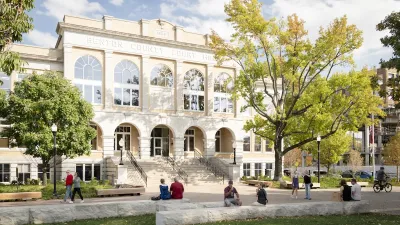In 2009, Memphis was one of the worst cities for cycling, but it quickly reversed its course, becoming the most improved city for cycling according to Bicycling magazine in 2012.
In a recent CityLab post, Eric Jaffe discusses a recent study by three urban scholars (Kevin Smiley of Rice University, Wanda Rushing of the University of Memphis, and Michele Scott of North Carolina State) that traces Memphis's history as a cycling-friendly city. In the 1970s and 1980s, white flight and interstate expansion led to high poverty (28 percent) and a declining city population. In 2008, the city was named one of America's worst cycling cities according to Bicycling magazine.
However, "this changed with the 2010 opening of the Shelby Farms Greenline, a 6.5-mile rails-to-trails route for walkers and cyclists that runs through the center of town. Despite little support from local officials, project advocates made the idea a reality through private donations and a federal grant. The greenline became an instant hit." With the momentum of the Shelby Farms Greenline and pressure from cycling advocates and Mayor AC Wharton, the city of Memphis built out more than 50 miles of bike lanes. Bikes helped to spur economic and cultural growth, and socially connected people too.
Following in the greenline's footsteps, another planned project aims to repurpose a former Harahan Memphis to Arkansas road into a cyclist and bicycle highway, and has been backed by a $15 million TIGER grant. Despite these positive impacts, the researchers note that the Harahan project will alter the character of the neighborhood, and without "a commitment to social preservation of place, however, the gentrification evidenced over the last decade may be furthered with the installation of the Harahan, thereby undermining the goals associated with utilising bicycling as a civic change agent."
FULL STORY: How Memphis Became a Great Bicycle City

Alabama: Trump Terminates Settlements for Black Communities Harmed By Raw Sewage
Trump deemed the landmark civil rights agreement “illegal DEI and environmental justice policy.”

Planetizen Federal Action Tracker
A weekly monitor of how Trump’s orders and actions are impacting planners and planning in America.

The 120 Year Old Tiny Home Villages That Sheltered San Francisco’s Earthquake Refugees
More than a century ago, San Francisco mobilized to house thousands of residents displaced by the 1906 earthquake. Could their strategy offer a model for the present?

Ken Jennings Launches Transit Web Series
The Jeopardy champ wants you to ride public transit.

BLM To Rescind Public Lands Rule
The change will downgrade conservation, once again putting federal land at risk for mining and other extractive uses.

Indy Neighborhood Group Builds Temporary Multi-Use Path
Community members, aided in part by funding from the city, repurposed a vehicle lane to create a protected bike and pedestrian path for the summer season.
Urban Design for Planners 1: Software Tools
This six-course series explores essential urban design concepts using open source software and equips planners with the tools they need to participate fully in the urban design process.
Planning for Universal Design
Learn the tools for implementing Universal Design in planning regulations.
Clanton & Associates, Inc.
Jessamine County Fiscal Court
Institute for Housing and Urban Development Studies (IHS)
City of Grandview
Harvard GSD Executive Education
Toledo-Lucas County Plan Commissions
Salt Lake City
NYU Wagner Graduate School of Public Service





























